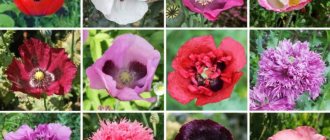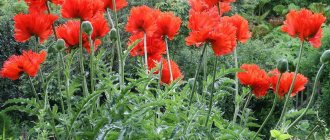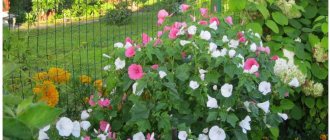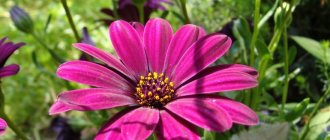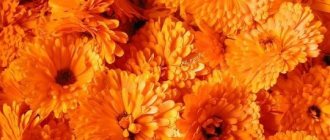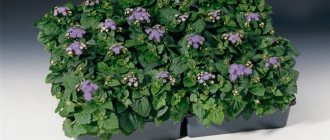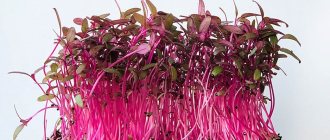Author: Elena N. https://floristics.info/ru/index.php?option=com_contact&view=contact&id=19 Category: Garden plants Published: January 29, 2019Last edits: November 03, 2020
- When to plant
- Growing conditions
- How and when to collect seeds
- Zinnia elegans
Zinnia (lat. Zinnia) belongs to the genus of herbaceous and shrubby perennials of the Asteraceae family, native to Southern Mexico, which received its name in honor of the pharmacologist and botanist Johann Gottfried Zinn from Göttingen, who, as director of the botanical garden, supplied Carl Linnaeus with herbarium material for research. The Aztecs cultivated zinnia since 1500, and it appeared in Europe in the 18th century, immediately becoming a favorite decoration for gardens and aristocratic receptions. By the twentieth century, zinnia was already cultivated on all continents, and from 1931 to 1957, the zinnia flower was even a symbol of the state of Indiana, USA. Today, about twenty species are known, many varieties and hybrids of this beautiful flower, distinguished by its beauty and undemanding conditions for growing.
Planting and caring for zinnia
- Planting: sowing seeds for seedlings - at the end of March or early April, transplanting seedlings into the ground - from mid to late May.
- Flowering: from mid-June until frost.
- Lighting: bright sunlight.
- Soil: light, nutritious, well-drained, neutral reaction.
- Watering: infrequent, but plentiful, at the root.
- Feeding: during the seedling period - three times with mineral fertilizers with low nitrogen content, after transplanting into the ground - at least twice: a month after planting and during the budding period.
- Reproduction: seed.
- Pests: May beetles and beetles, aphids, slugs and snails.
- Diseases: powdery mildew, fusarium, bacterial spot, gray rot.
Read more about growing zinnia below.
Soil and containers for sowing zinnia seedlings
It is advisable to sow zinnias in individual containers that do not require replanting - peat pots or peat cassettes. They develop quickly and powerfully, form strong roots, require a lot of space and bloom faster if the seedlings are not disturbed. But they are not afraid of transplantation.
If it is not possible to sow in peat containers, use sowing in boxes and general containers, selecting them so that there is no need for diving or it would be possible to carry out diving without serious injury to the roots. The standard depth of containers is 10 cm. When sowing in ordinary flat containers, you need to immediately prepare deep individual glasses, making sure that the earthen ball does not collapse when planting the seedlings and that the plants do not outgrow.
For zinnia, universal soil for seedlings - flower or vegetable - is quite suitable. The main attention should be paid to the light, loose texture and neutral pH values. It is not necessary to disinfect the soil before sowing for zinnias.
Botanical description
Depending on the type and variety, the height of zinnia can be from 20 to 100 cm and above. The leaves of zinnia are entire, sessile, ovate, pointed towards the apex, pubescent with stiff hairs, arranged whorled or opposite. The inflorescences are apical single baskets with a diameter of three to fourteen centimeters, located on long peduncles. Reed zinnia flowers, arranged tiledly in one or several rows, white, purple, orange, yellow, red - all possible colors, except shades of blue; middle, tubular flowers are small, yellow or red-brown. The fruit is an achene with a tuft. Zinnia blooms from mid-June until frost, being resistant to heat and drought.
The zinnia plant is cultivated as a bright and unpretentious garden plant that stands well as a cut flower. Perennial zinnia grows only in areas with warm winters. In our climate, zinnia in the garden is exclusively an annual plant, since it is not able to survive even short and minor frosts. Summer residents call this flower major. Annual zinnias and marigolds, daisies and marigolds are the main flowers for the rustic-style landscape, which is increasingly becoming fashionable in Europe. Zinnia is also appropriate in a flower bed with so-called noble flowers; it is also grown in the garden among vegetables, using its remarkable ability to stretch upward, creating almost no shadow.
Diseases and pests
Problems:
- slugs and snails are collected by hand. Prevention: removing weeds, sprinkling lime on site boundaries and row spacing;
- aphids: use a solution of tar soap or special industrial products;
- spotting: there are no effective ways to combat it. The affected parts or plant are completely removed;
- gray rot: chemicals are used;
- Powdery mildew: sign of manifestation - light spots on plants. They use drugs that destroy microorganisms.
Zinnia flowers amaze and captivate with their reliability, aesthetics and incredible charm. In the garden, harmonious rows of zinnia petal flowers form an expressive and loose “cushion” on which lie doll-like tubular flowers, painted in shades from lemon to wine-lilac.
The variety of shapes, colors and relative ease of care make it possible to grow zinnia both for garden decoration and for cutting. Unassuming zinnias will delight and inspire all season long, without requiring every minute of care. How nice it is to sit in the garden near the zinnias with a mug of herbal tea, inhale their heady aroma, listen to the birds singing and make plans for tomorrow.
Growing zinnia from seeds
How to sow seeds
Perennial zinnia, like annual zinnia, reproduces generatively. In places with a warm climate, where there are no frosts in May, it is possible to plant zinnia directly in the ground, but if night frosts are common in your area, be aware that zinnia seeds sown in the ground will die at a temperature of -1 ºC. That is why experienced gardeners believe that it is better to grow and harden this plant as seedlings, and then planting zinnia in the ground and subsequent rooting will be successful.
- Cabbage plants: fruit and ornamental
Before sowing, wrap zinnia seeds in a cloth or gauze soaked in epin to determine which ones are viable and which are not. Fresh seeds hatch within a couple of days, while old ones will take a week to sprout.
At the end of March or beginning of April, germinating seeds of two or three pieces are sown generously to a depth of one centimeter in peat pots with a moist substrate, which will subsequently avoid picking, which this crop does not like. The crops are moistened and placed in a bright place. The optimal temperature for germination of zinnia is 22-24 ºC. If you do everything correctly, sprouts will appear within a few days.
In the photo: How zinnia blooms
Seedling care
Young plants quickly form adventitious roots, and if the zinnia seedlings have stretched out, just add a little soil to the pots. My zinnias did not grow very tall, but a friend complained that she put the crops in partial shade, and the seedlings turned into sickly translucent sprouts, so remember that zinnia seedlings require bright, indirect light. If the seeds are sparsely sown, you will not have to pick the seedlings, especially since zinnia does not tolerate picking well. At the end of May, in order for the planting of zinnia to be successful, the seedlings begin to be hardened by taking them out into the fresh air for a while during the day.
How to collect zinnia seeds for sowing
Zinnias are most often grown by cutting off wilting heads to prolong their flowering period. Leaving the inflorescences, you can wait for the oval-wedge-shaped, flattened, special achenes to ripen. Full-fledged zinnia seeds can only be obtained from healthy plants that have undergone normal development, have not outgrown at the seedling stage and are not transplanted into the soil too early. It is worth choosing the strongest bushes, leaving baskets for collecting seeds on the shoots of the first order.
On average, seeds ripen 60-65 days after flowering. The achenes can be tied to protect them from spilling, but zinnias are usually not prone to unexpected cracking and collecting the achenes from them is quite easy if the deadlines are met.
Freshly collected seeds are dried in the dark at normal temperatures for several days and sorted. Due to cross-pollination, usually even when collecting boxes of the variety you like, the seeds will have a wide range of characteristics.
Zinnia seeds are immediately divided into groups, sorted by shape and size. Simple inflorescences produce brown, corymbose and flat seeds; semi-double or double - elongated, dark and narrowed at the base, but large-flowered double zinnias can be obtained if you select grayish seeds with an even more elongated shape and an awl-shaped outgrowth. Store zinnia seeds protected from light, in “breathable” paper bags or packaging in the cold, but without freezing temperatures.
Zinnia seeds retain their viability very well and can be used for at least two, and if stored in cold conditions, for 4 years after collection. Checking for germination and culling after soaking allows you to get uniform shoots. Zinnia seed germination is high, up to 95% in the second year.
There are no difficulties in choosing zinnia seeds. This is an affordable plant, represented by proven varieties and mixtures, often found in seed mixtures for balconies or flower beds. Since the seeds remain viable for a long time, it is enough to check the completeness of the information, the characteristics of the variety and choose trusted suppliers.
For zinnia, universal soil for seedlings - flower or vegetable - is quite suitable.
Planting zinnia in open ground
When to plant
When to plant zinnias in open ground , or rather, when can you plant zinnia seedlings? Zinnia is planted in the ground in the second half of May, towards the end of the month, when the danger of return frosts has passed. The plant prefers bright areas, protected from the wind, with neutral, well-drained, nutritious soil. Before planting zinnia, the intended area is cleared of weeds by digging the soil to a depth of 45 centimeters and adding leaf humus, compost or rotted manure to it while digging at the rate of 8-10 kg per m², and it is best to do this in the fall.
How to plant
Zinnia flowers are planted at a distance of 30-35 cm of one specimen from another by transshipment or together with a peat pot. You will see zinnia blooming in early July.
How to plant zinnia?
It is recommended to carry out this event in May-June, when night frosts have completely stopped and the earth has warmed up sufficiently. This condition is mandatory, since zinnia may die at low temperatures.
The technology for planting young seedlings is as follows:
- if, according to the recommendation, you prepared the site in the fall, then before planting the seedlings you need to dig it up again;
- we make rows and holes - since this crop needs space, it is necessary to leave distances between the bushes: at least 10 cm for low-growing plants, at least 20 cm for medium-growing ones, about 30 cm for tall ones and about 40 cm between rows;
- if the bed is in a low place, then to ensure good drainage, a little clean sand should be poured into the bottom of each hole;
- we remove the seedlings from the pots and, without shaking off the substrate, place them in the holes;
- Sprinkle each bush in the root area with soil and mulch with dry peat - the last step will help retain moisture in the substrate.
Zinnia care
Growing conditions
If planting the zinnia was successful, you can talk about caring for it, which consists of regularly loosening the soil, weeding and infrequent but abundant watering at the root so that water does not fall on the flowers. When zinnia begins to bloom, remove faded flowers in a timely manner. The powerful stems of zinnia do not need tying or support.
When to plant chrysanthemums to get lush blooms
Fertilizer
From the moment the seedlings emerge until the time when the zinnia is planted in the ground, the seedlings are fed with mineral fertilizers with a low nitrogen content three times. A plant planted in the ground is fertilized with mineral fertilizers or liquid manure at least twice during the summer: the first time a month after planting, and the second time during the budding period. That's all the trouble. As you can see, planting and caring for zinnia is not at all burdensome.
How to pinch
Readers often ask whether they pinch zinnias and, if so, how and when to do it. If you want the zinnia to bush, you need to pinch it above the third or fourth pair of leaves while still in seedlings, although you can do this when the zinnias in the open ground have already taken root and taken root. But if you want to grow elegant flowers on long stalks for cutting, pinching zinnias is not necessary.
In the photo: Variegated zinnia
Pests and their control
The most common pests that bother zinnia are aphids, chafers, snails and slugs.
Gastropods are usually lured by beer bowls placed here and there around the site, or pieces of slate or roofing felt scattered between plants, under which mollusks like to crawl. You will have to collect them manually.
May beetles will also have to be collected by hand and thrown into a bucket of soapy water. Aphids are destroyed by spraying zinnias with a solution of tar soap at the rate of 10 g per liter of water, and in case of severe infestation - with a solution of Fufanon or Actellik, prepared in accordance with the instructions.
Diseases and their treatment
Among the diseases, it is possible for zinnia to become infected with gray rot, fusarium, bacterial spot, but most often - powdery mildew. If at least one zinnia leaf is disfigured by gray-brown round spots left on the plant by bacterial spotting, take immediate action: tear off the leaves that have traces of the disease, and in case of severe infection, destroy the entire plant - there is no cure for this disease.
- Irises in the garden
Gray mold and fusarium are treated with fungicides (Topsin-M, Fundazol), as well as powdery mildew, which appears as a white coating on the above-ground parts of zinnia - Topaz, Skor, Topsin are more suitable among fungicides to get rid of this scourge.
It must be said that diseases arise primarily due to violations of the rules for growing the plant, for example, due to too thick planting or excessive watering, so first diagnose the zinnia problem, eliminate it, if possible, and then work on the mistakes - re-read rules for plant care, find and analyze the discrepancy between them and how things really are. This is the only way you can avoid troubles in the future.
In the photo: Dense zinnia bushes
What can threaten zinnias?
Plants can be affected by 3 unfavorable factors:
There are different methods of control against various pests. So only manual cleaning will help against snails and slugs. The Actellik solution will save you from aphids, and removing the affected areas will save you from diseases such as powdery mildew, fusarios and gray mold. After this, the plant must be treated with fungicides.
You can use drugs such as “Skor”, “Vectra” or “Topaz” for powdery mildew. Help against gray rot: colloidal sulfur, Maxim or Fundazol. You can try to get rid of aphids using “Aktor” or “Fitoverm”.
These diseases can appear due to excessive humidity. In wet weather, you should be twice as careful and inspect the plants more often in order to prevent the development of diseases in time.
Zinnia after flowering
How and when to collect seeds
Zinnia seeds ripen about two months after flowering begins, so mark a few of the first ones to open. Shoots of the first order have the best quality seeds, so you should remove all side shoots from the specimens you have chosen for seed ripening. When the ripe baskets turn brown, they are cut off, dried, the seeds are removed, cleaned of dry remains of flowers and stored in a dry place at a constant temperature. Zinnia seeds remain viable for 3-4 years.
On the picture:
Perennial zinnia in winter
As has been mentioned more than once, zinnia is grown in the garden as an annual plant. But if your zinnia does not grow in open ground, but in a container or pot, then with the onset of autumn, bring the flower indoors and care for it like a houseplant, turning it from an annual zinnia into a perennial one.
Zinnia seeds
The simplest method of planting is considered to be seed. And first, let's find out what zinnia seeds look like. They come in three types: scute-shaped, with an awl-shaped tongue, and spear-shaped.
On a note! It is worth noting that all three types of seeds can be found in the same seed head, and each variety often grows into plants belonging to different varieties! For this reason, it is better to separate each species immediately after collection!
What flowers can be obtained from certain seeds?
- If the seed has the shape of a shield, then simple zinnias will grow from it, even if it was collected from a double flower.
- Spear-shaped seeds produce semi-double or double plant species.
- From seeds with an awl-shaped tongue (they will be the darkest) you can get the most luxurious flowers - double ones.
Undoubtedly, the most spectacular are double inflorescences. However, it is necessary to remember that they will become so only with proper care. If you are not sure that you can devote enough time to your zinnia, then it is better to focus on semi-double or simple varieties. In addition, the latter are much less susceptible to diseases, tolerate the vagaries of the weather relatively calmly and forgive quite a few mistakes of novice gardeners.
Types and varieties
Of the more than twenty species of zinnia, only four are grown in culture: graceful zinnia, narrow-leaved zinnia, also known as Hage zinnia, thin-flowered zinnia and zinnia linearis. The first two species served as the basis for fruitful breeding work, and, thanks to its results, today we cultivate in our gardens not only the main types of zinnia, but also many beautiful varieties and hybrids of this plant.
Zinnia elegans
Herbaceous annual up to 1 meter high and higher with simple white, orange and pink inflorescences. The stem is straight, mostly unbranched, round in cross-section, densely pubescent with hard hairs; all shoots end in apical inflorescences-baskets. The leaves are sessile, entire, ovate, with a pointed apex, 5-7 cm long and 3-4.5 cm wide, the surface of the leaf is pubescent, like the stem. Inflorescences with a diameter of 5 to 16 cm, simple, semi-double and double, consist of reed flowers up to 4 cm long and up to 1.5 cm wide, painted in all kinds of colors, except shades of blue, and median, tubular flowers of yellow or reddish-brown color .
Types and varieties of celosia - an amazingly beautiful flower
Graceful zinnia blooms in June and can bloom until the coldest weather. In nature, it is most common in southern Mexico. In culture since 1796. Varieties and hybrids of graceful zinnia are classified according to several characteristics: by the structure of the inflorescences, by their shape, by the height of the stem and by the timing of flowering.
In the photo: Elegant zinnia (Zinnia elegans)
According to the timing of flowering, there are early-blooming, mid-blooming and late-blooming zinnias.
According to the structure of the inflorescences, varieties are divided into simple, semi-double and double.
Depending on the height of the stem, it happens:
- tall zinnia (60-90 cm), grown for cutting, since it looks somewhat bulky in a flowerbed;
- medium zinnia (35-50 cm) – suitable both for cutting and for decorating flower beds;
- Dwarf zinnia, or low-growing zinnia (15-30 cm) - usually these are well-branched bushes, grown both in flower beds and in balcony containers and simply in pots.
In the photo: Elegant zinnia (Zinnia elegans)
Zinnias are divided into seven categories based on the shape of their inflorescences. In our climate, the most commonly grown of these are:
- Zinnia dahlia - powerful bushes, spreading or compact, 60 to 90 cm high with shoots of the first order. The leaves are large - up to 12 cm long, the inflorescences are hemispherical, double, up to 14 cm in diameter. Varieties: Violet - terry zinnia 60-75 cm tall with dense inflorescences of different shades of purple, Orange Koenig - on stems 60 to 70 cm high, bright red-orange double inflorescences up to 14 cm in diameter, Polar Bear - a compact plant up to 65 cm high cm with densely double white inflorescences with a greenish tint;
- Lilliputian zinnia, or pompon zinnia, is a compact branched bush no higher than 55 cm with a large number of shoots of the second, third and fourth order, small leaves and small inflorescences, only up to 5 cm in diameter, resembling a pom-pom on a hat. Varieties: Red Riding Hood - a densely double variety up to 55 cm high with truncated-cone-shaped or rounded inflorescences of a bright red hue; Tom Thumb is a compact bush up to 45 cm in height with dense double red inflorescences in the shape of a slightly flattened ball; Tambelina is a variety mixture of different shades with a bush height of up to 45 cm and inflorescence diameter from 4 to 6 cm;
- zinnia fantasy - almost spherical compact bushes 50-65 cm high with large leaves and loose curly inflorescences, in which narrow reed flowers are rolled into tubes and curved in different directions, and at the ends some of them are forked. Varieties: Fantasy - a bush up to 60 cm high with double loose inflorescences up to 10 cm in diameter in different shades - purple, red, bright yellow, purple, red-orange, pink, white, salmon, etc.; The gift is a bright red zinnia.
In the photo: Elegant zinnia (Zinnia elegans)
Also popular in the culture of other countries:
- Californian giant zinnia - varieties of double zinnias with a diameter of up to 16 cm with imbricated reed flowers and a stem height of up to 1 meter or more. They differ in relatively late flowering;
- giant cactus zinnia - varieties ranging in height from 75 to 90 cm with double inflorescences up to 11 cm in diameter with reed flowers rolled into a tube, sometimes wavy with raised tips;
- zinnia supercactus - varieties with the same inflorescences as those of giant cacti, but no more than 60 cm in height;
- zinnia scabiosa (also anemone-flowered) - varieties with an inflorescence up to 8 cm in diameter, in which reed flowers are arranged in one row around the middle, consisting of tubular flowers overgrown with corollas, which makes the middle look like a hemisphere, colored to match the reed flowers.
In the photo: Elegant zinnia (Zinnia elegans)
Zinnia angustifolia
Or Zinnia haageana - also native to Mexico. This is an annual erect plant that forms branched bushes. The leaves are sessile, lanceolate or elongated, pointed. The inflorescences are small, simple or double, bright orange. Varieties:
- Whitewashing trees in autumn: when and what to whitewash
- Glorienshain is a highly branched bush up to 25 cm tall with double inflorescences, in which the reed flowers are dark orange at the base and red-brown at the ends;
- Persian Carpet Mixed series with semi-double bicolor inflorescences of red with lemon, white, orange and yellow - a large mass of this zinnia really looks like an oriental carpet.
- variety mixtures Starbright and Classic have also become famous - plants with inflorescences of white, yellow and orange tones up to 30 cm in height with a thin and weak, but highly branched creeping stem. These zinnias are mostly used as ground cover plants.
- Zinnias of the Sombrero variety look nice in a flower bed - inflorescences of a red-brown hue with an orange border.
In the photo: Zinnia angustifolia
Zinnia tenuiflora
It is usually used to create landscape flower beds and consists of bushes about 60 cm high with angled thin stems of a reddish hue. The inflorescences are small, up to 3 cm in diameter, the reed flowers are narrow, bent, with curled tips, of a purple hue. Varieties: Red Spider.
Zinnia linearis
It is sometimes confused with angustifolia zinnia because its leaves are thin and sharp, like the ends of nail scissors. This is the smallest of the cultivated species - branching, almost spherical bushes grow no higher than 35 cm. Linearis inflorescences are small, reed flowers of yellow color with an orange edge. Zinnia linearis is suitable for growing in pots, in balcony containers, on alpine hills and in small flower beds. Varieties:
- Golden eye - white center of tubular flowers, reed flowers are white - the variety is similar to an ordinary chamomile;
- Caramel – the color of the reed flowers is caramel yellow, the center is black;
- Yellow Star is a variety with yellow inflorescences.
In the photo: Zinnia linearis
From crossing the Haage zinnia and the graceful zinnia, many hybrids were bred, in particular, the Proffusion series, which is very popular among gardeners - low bushes up to 35 cm, strewn with small multi-colored daisies. The Magellan series is also gaining popularity - bushes up to 35 cm tall with densely double dahlia-shaped inflorescences with a diameter of up to 10 cm in coral, cream, orange, pink, red, cherry, salmon and yellow colors. The Swizzle series has recently appeared in gardens, consisting so far of two varieties - Cherry Ivory with cherry baskets with cream tips of reed flowers and Scarlett Yellow with red inflorescences and bright yellow tips.
Reproduction methods
Zinnia is grown both by seedlings and by direct sowing in open ground (in the southern regions). Of course, if a gardener wants to get early flowering of zinnias, they resort to the seedling method.
Propagation of zinnia by seedlings
Sowing of seedlings is carried out in early March in the usual soil for summer growers. It is important to learn how to grow healthy seedlings. Zinnia grows and develops quickly, so if you sow the seeds too early, the seedlings will stretch out, and then it will be difficult to plant them in a permanent place.
For sowing, a substrate is used: garden soil, peat and sand (1: 2: 0.5). The soil is disinfected so that the seedlings are not damaged by the black leg (roasted in the oven or watered with a solution of potassium permanganate).
Before sowing, it is important to disinfect seedling containers (even new ones) in a solution of bleach or copper sulfate.
Low temperature (approximately +15°C) is optimal for seedlings. It is important to consider the sowing depth: it should be equal to three times the thickness of the seed. The seedlings are planted in boxes after the formation of two pairs of true leaves. This is done extremely carefully so as not to damage the roots. And then they are grown in a light greenhouse at a temperature of +18...+20°C.
Plants are planted in an unprotected place when the weather is warm without frost. “Mexican fireworks” does not tolerate temperatures below 0°C; even short-term frosts will destroy this plant variety.
Zinnia develops better on loose, permeable soils, requires heat and sun, and is drought-resistant. Majors are planted avoiding dense plantings to ensure breathability. In the southern regions, seedlings are planted in April-May at a distance of 40-30 cm for tall varieties and 15 cm for short ones. Moisturize as needed.
Drought-resistant zinnia tolerates a lack of moisture more easily than its excess.
If you feed zinnia regularly, it will bloom from June to September-October.
This crop is grown both in a greenhouse to achieve early flowering and in late autumn. Low, early-blooming varieties are suitable for forcing.
Propagation of zinnia by seeds
Zinnia also reproduces by seeds. Gardeners living in areas with a warm, mild climate plant the seeds directly into the flower garden.
Zinnia seeds are selected. They are wrapped in damp gauze and waited for several days. Quality seeds germinate. Then they prepare a place for planting, dig up the ground, and make grooves. Seeds of different varieties are sown in separate containers to avoid confusion. Seeds are sown in them and covered with a layer of sand. The top of the crops is covered with film to form a greenhouse.
The favorable temperature regime for successful seed germination is about +20...+23°C.
During the period of mass flowering, strong plants are chosen to obtain seeds. After drying, the inflorescences are threshed and cleaned. Germination persists for 3-4 years. In a city apartment, packets of seeds are placed in a glass jar with a lid or stored in a closed plastic bag. It is best to place containers with seed on the windowsill, closer to the glass.
When growing seedlings, gardeners cut the best sprouts with nail scissors rather than pulling them out. The slightest damage to the roots will lead to trouble.
It is important to remember that zinnia is a cross-pollinated plant, so to obtain seeds, spatial isolation between varieties of at least 200 meters is necessary.
Winter care
Before the onset of winter, the flower should be properly prepared. To do this, you need to remove the part of the plant that is located above the ground line, leaving only a few centimeters. After this, it is also worth loosening the soil around the zinnia and covering the surface of the soil with foliage, and laying material on top of this layer with a windproof base.
But, as a rule, perennials are transplanted into pots and then moved to a warm room.

